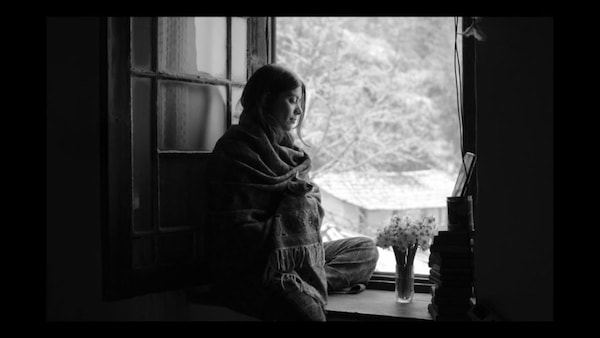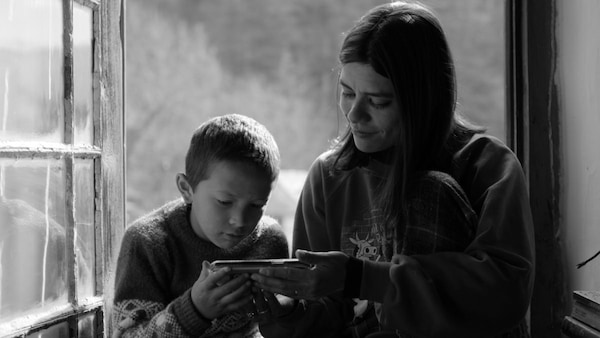Second Chance Is A Poetic Feature Debut About Revival & Unlearning
Subhadra Mahajan’s feature is as much about finding light at the end of the tunnel as it is about scouring light in the tunnel.

Still from Second Chance.
Last Updated: 09.27 AM, Jun 14, 2025
THE IDEA OF A SECOND CHANCE is often linked to redemption, an opportunity to right a wrong. In Subhadra Mahajan’s stunningly shot, monochrome feature, Second Chance, the prospect gathers a restorative quality. The filmmaker slows down the immediacy, making second chances more about unlearning than learning. The difference is slight but lends ingenuity to a familiar premise.
Nia (Dheera Johnson) is an affluent young woman who has retreated to the hills. Not much information is laid out, but not much is required. The film opens with a black screen, punctuated with her voice – shaky, disillusioned and desperate. She is trying to reach out to someone called Kabir over the phone to inform him that she has taken the pills. The next moment, Nia stands facing the snow-clad mountains. The juxtaposition of her frail being with the towering silhouette informs the narrative context, conveying her existential confinement. Still, the possibility of the ice thawing underlines the spiritual subtext of the film. Mahajan’s feature is as much about finding light at the end of the tunnel as it is about scouring light in the tunnel.

After arriving in the Himalayan region, Nia starts living in what is presumably her family’s summer house. Mahajan remains frugal with exposition but offers some insight. Nia is a failed entrepreneur. She loves dancing, a detail that assumes importance when one considers the extent to which the current upheaval might change her relationship with her body. She is familiar with this place; the caretaker knows her, and remnants of her past lie scattered in the house. She unearths some toys and flinches on seeing a baby doll. Her phone, struggling to catch the network, is stationed near the window while she remains in bed. The distance doubles for her detachment from the outside world. Her concerned parents call, and she tries messaging Kabir, but she remains on her own.
Disrupting this is Sunny (Kanav Thakur), the unruly son of the caretaker. Once the latter leaves for urgent work, Sunny and his grandmother, Bhemi (Thakri Devi), take care of Nia. They keep making food, and she keeps sending them back, till something shifts. It happens gradually and possibly due to Sunny’s innocent disregard for her boundaries. Obsessed with Superman, he bullishly saunters into her space and brings Nia within the ambit of their regular lives.

For those living in urban chaos, the hills represent a utopian state for the peace they enfold. Mahajan confirms this but resists burdening the locals with the sole task of being helpers. Not that they are not, but their act is driven by empathy and not subservience. In the filmmaker’s purview, Sunny and Bhemi are as much flesh and blood, mired in turmoil, as the city-bred Nia. They even have a past and a sense of routine. Sunny’s mother died at childbirth; Bhemi has a suitor who bashfully foresees a life together. These little details — a thing of wonder how Mahajan includes them in the lean runtime — entitle them to be on equal footing with the woman at the centre.
This equality, rare in a story like this, advocates for a coexistence that thrives on playful exchange (distilled in a lovely scene where Nia is tricked into washing her hands in cold water by Bhemi) and pockets of deep reflection. Bhemi shares with Nia an instance from her past tinged with regret. In another moment, she coldly states that women in the hills are perceived to be good only for birthing children and physical labour. Such uncluttered writing makes protagonists out of everyone and acknowledges grief by offering it company.

The filmmaking responds to this. When Second Chance opens, Nia is mostly seen in wider shots walking about on her own. The framing lends her a centrality, as if only she and her problems exist in this part of the world. But as the narrative unfolds, more close-ups are used — for her and the rest; the approach widens our investment to others.
Working with first-time actors (all three are debutants and natural before the camera), Mahajan displays a genuine knack for mining humour in regular situations. She also refuses to overstress, letting her style fill in the gaps. For instance, Second Chance’s ethos of finding hope in darkness is reflected in the film’s black and white palette. All the characters, including Nia, are straddling aspiration and despair; the picture changes when the light falls on them differently.

This becomes the guiding principle of the compelling debut that echoes with an original voice. The missteps are few, like Nia visiting an ex and engaging in conversations so stilted that it dissociates one from the world of Mahajan’s making. But in the larger picture, her film culminates as a poetic triumph that subverts the familiar setting of a broken girl looking to heal by revealing the brokenness in others. It remains therapeutic still, insisting in its optimism that, often, second chances are about revival rather than redemption.
